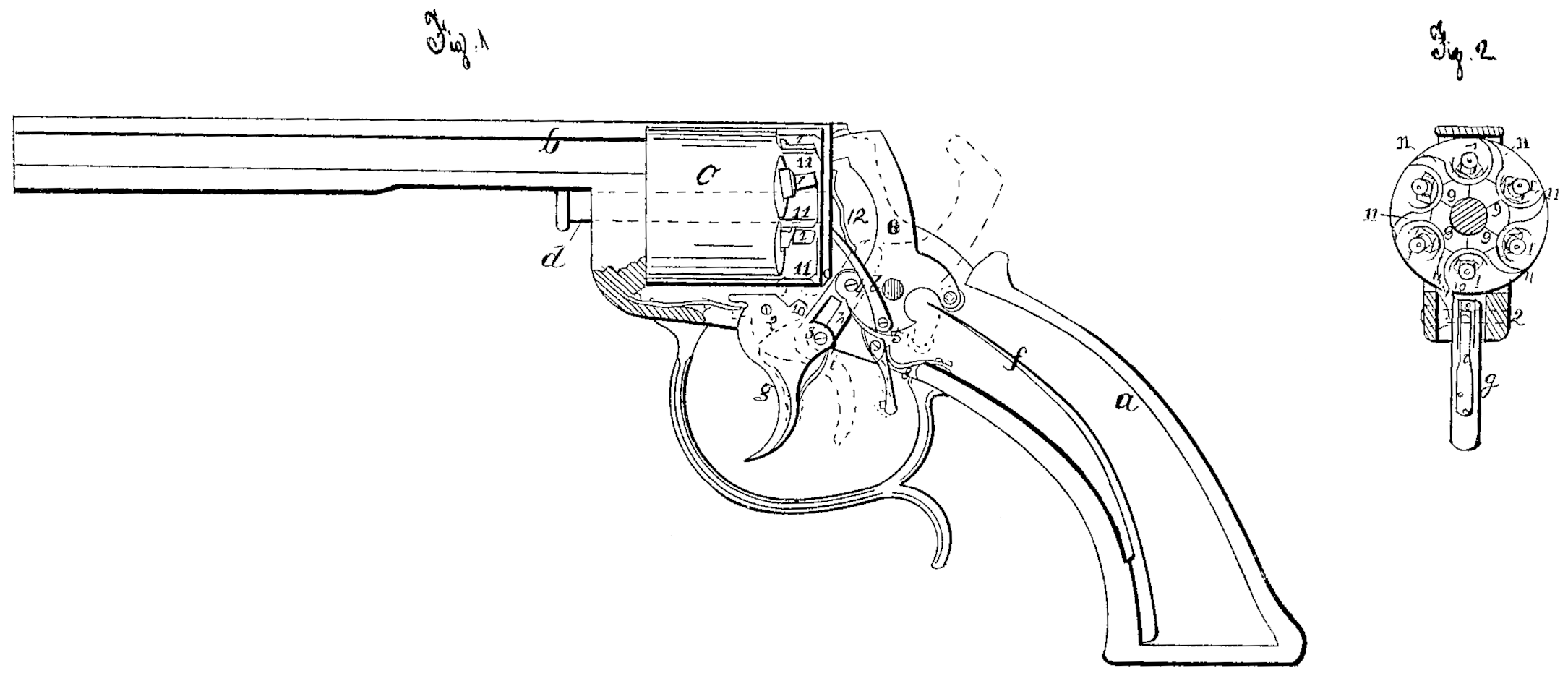US 21623
UNITED STATES PATENT OFFICE.
WILLIAM PALMER, OF NEW YORK, N. Y.
IMPROVEMENT IN REVOVING FIRE-ARMS.
Specification forming part of Letters Patent No. 21,623, dated September 28, 1858.
To all whom it may concern:
Be it known that I, William Palmer, of the city, county, and State of New York, have invented, made, and applied to use a certain new and useful Improvement in Repeating Fire-Arms; and I do hereby declare that the following is a full, clear, and exact description of the construction and operation of the same, reference being had to the annexed drawings, making part of this specification, wherein—
Figure 1 is a side elevation with the cap-plate removed; and Fig. 2 is a cross-section, showing the rear end of the chambers and the manner of locking.
Similar marks of reference denote the same parts.
In several repeating fire-arms that have heretofore been constructed the chambers have been revolved by the pull of the trigger, which at the same time cocks the hammer and discharges it, firing the piece. In other fire arms the hammer is cocked by hand, and then the trigger is pulled to discharge the piece. In the former instance the fire-arm is self cocking and revolving, possessing advantages in this respect over the latter instance; but in this last case there is an advantage in being able to take better aim, and requiring less power to discharge the piece than where the continuous pull cocks and discharges.
My invention combines the advantages of both the foregoing characters of repeating fire arms; and it consists in an arrangement of sears, hammers, and triggers, whereby the commencement of the pull on the trigger cocks the hammer and revolves the piece, and then it is disconnected from the other parts and gives a pause in which to take aim, and then the continuation of the pull on the trigger disconnects a second or hair trigger by a very easy pull, which causes the hammer to fire the piece.
In the drawings, a is the stock; b, the barrel; c, the chambers or breeches on the center pin d. All these parts may be of any usual form or size.
e is the hammer, actuated by the mainspring if and taking the nipples or cones 11, as usual.
g is the trigger on the center-pin 2, formed as a slot at its rear part, carrying a knife-edge pin, 3, that passes through a slotted link, h, that is jointed at 4 to the hammer e, and formed with an offset in said slot, setting over the said knife-edge pin 3, and i is a spring keeping the link 1, toward the knife-edge 3. On pulling the trigger g the offset of the link h, taking over the knife-edge 3, causes said hammer e to be thrown to the rear, cocking the piece, and the sear or hair-trigger k falls into the notch 5 on the tumbler of the hammer, holding the same in the cocked position at the same moment the part 6 at the rear of the chambers forces the offset of the slotted plate h off the knife-edge 3, and the trigger is free from all strain, and by a momentary pause the party firing the piece is able to take correct aim, when, upon continuing the pull, the two triggers g and k coming in contact, the latter is disengaged and the piece discharged.
7 is the spring which returns the trigger g to its forward position, and 8 is the spring to the hair-trigger.
The revolving of the barrels is accomplished by the pawl l, attached to the tumbler of the hammer, taking the ratchet-teeth 9 on the rear of the chambers c, and the blocking of the chambers in place is effected by the forked part 10 of the trigger g coming on each side of the division 11 between the recesses for cones 1.
12 is the spring that keeps the pawl l to its work.
It will be apparent that the slotted plate or sear h might be slightly varied in its construction, so long as it becomes disconnected or relieved immediately after the hair-trigger is takes the tumbler of the hammer e, and the said hair-trigger may be placed nearer to or farther from the trigger g, so as to allow a greater or less pause between the cocking and discharging, as set forth.
From the foregoing it will be seen that my pistol possesses the advantages of the self cocking and revolving fire-arms, and also of those repeating pistols that are cocked by hand, because the first part of the pull cocks the piece, and then the trigger is almost entirely relieved, so that a correct aim can be taken, and then the piece discharged by the further motion of the trigger, and these operations can be repeated Without changing the grasp on the stock, whereas in those pistols that are cocked by hand the thumb or fingers have to be moved, precluding a steady aim.
What I claim as my invention, and desire to secure by Letters Patent, is—
The combination of the trigger g, hammer e, sear or hair-trigger k, and slotted plate h, or its equivalent, substantially as specified, whereby the hammer is cocked by the pull of the trigger g, and then disconnected therefrom, so that the strain is transferred from the trigger g to the hair-trigger k, and then the latter is disconnected by the farther pull of the trigger g, as set forth.
In witness whereof I have hereunto set my signature this 14th day of August, 1858.
WILLIAM PALMER.
Witnesses:
Lemuel W. Serrell,
Thomas G. Harold.

